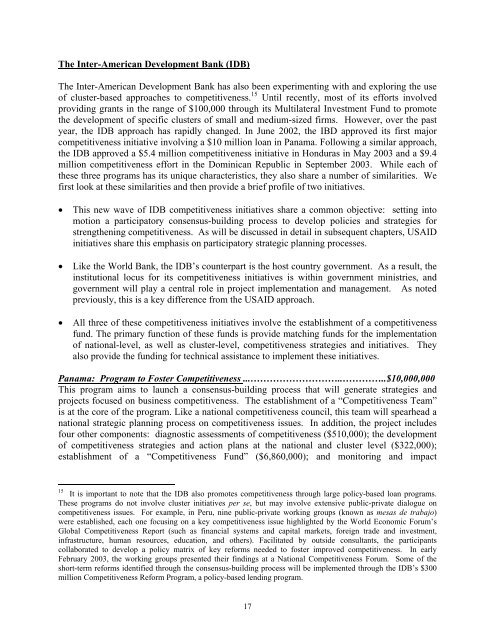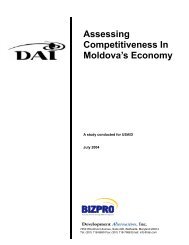Promoting Competitiveness in Practice - Economic Growth - usaid
Promoting Competitiveness in Practice - Economic Growth - usaid
Promoting Competitiveness in Practice - Economic Growth - usaid
Create successful ePaper yourself
Turn your PDF publications into a flip-book with our unique Google optimized e-Paper software.
The Inter-American Development Bank (IDB)<br />
The Inter-American Development Bank has also been experiment<strong>in</strong>g with and explor<strong>in</strong>g the use<br />
of cluster-based approaches to competitiveness. 15 Until recently, most of its efforts <strong>in</strong>volved<br />
provid<strong>in</strong>g grants <strong>in</strong> the range of $100,000 through its Multilateral Investment Fund to promote<br />
the development of specific clusters of small and medium-sized firms. However, over the past<br />
year, the IDB approach has rapidly changed. In June 2002, the IBD approved its first major<br />
competitiveness <strong>in</strong>itiative <strong>in</strong>volv<strong>in</strong>g a $10 million loan <strong>in</strong> Panama. Follow<strong>in</strong>g a similar approach,<br />
the IDB approved a $5.4 million competitiveness <strong>in</strong>itiative <strong>in</strong> Honduras <strong>in</strong> May 2003 and a $9.4<br />
million competitiveness effort <strong>in</strong> the Dom<strong>in</strong>ican Republic <strong>in</strong> September 2003. While each of<br />
these three programs has its unique characteristics, they also share a number of similarities. We<br />
first look at these similarities and then provide a brief profile of two <strong>in</strong>itiatives.<br />
• This new wave of IDB competitiveness <strong>in</strong>itiatives share a common objective: sett<strong>in</strong>g <strong>in</strong>to<br />
motion a participatory consensus-build<strong>in</strong>g process to develop policies and strategies for<br />
strengthen<strong>in</strong>g competitiveness. As will be discussed <strong>in</strong> detail <strong>in</strong> subsequent chapters, USAID<br />
<strong>in</strong>itiatives share this emphasis on participatory strategic plann<strong>in</strong>g processes.<br />
• Like the World Bank, the IDB’s counterpart is the host country government. As a result, the<br />
<strong>in</strong>stitutional locus for its competitiveness <strong>in</strong>itiatives is with<strong>in</strong> government m<strong>in</strong>istries, and<br />
government will play a central role <strong>in</strong> project implementation and management. As noted<br />
previously, this is a key difference from the USAID approach.<br />
• All three of these competitiveness <strong>in</strong>itiatives <strong>in</strong>volve the establishment of a competitiveness<br />
fund. The primary function of these funds is provide match<strong>in</strong>g funds for the implementation<br />
of national-level, as well as cluster-level, competitiveness strategies and <strong>in</strong>itiatives. They<br />
also provide the fund<strong>in</strong>g for technical assistance to implement these <strong>in</strong>itiatives.<br />
Panama: Program to Foster <strong>Competitiveness</strong> ...………………………..…………..$10,000,000<br />
This program aims to launch a consensus-build<strong>in</strong>g process that will generate strategies and<br />
projects focused on bus<strong>in</strong>ess competitiveness. The establishment of a “<strong>Competitiveness</strong> Team”<br />
is at the core of the program. Like a national competitiveness council, this team will spearhead a<br />
national strategic plann<strong>in</strong>g process on competitiveness issues. In addition, the project <strong>in</strong>cludes<br />
four other components: diagnostic assessments of competitiveness ($510,000); the development<br />
of competitiveness strategies and action plans at the national and cluster level ($322,000);<br />
establishment of a “<strong>Competitiveness</strong> Fund” ($6,860,000); and monitor<strong>in</strong>g and impact<br />
15 It is important to note that the IDB also promotes competitiveness through large policy-based loan programs.<br />
These programs do not <strong>in</strong>volve cluster <strong>in</strong>itiatives per se, but may <strong>in</strong>volve extensive public-private dialogue on<br />
competitiveness issues. For example, <strong>in</strong> Peru, n<strong>in</strong>e public-private work<strong>in</strong>g groups (known as mesas de trabajo)<br />
were established, each one focus<strong>in</strong>g on a key competitiveness issue highlighted by the World <strong>Economic</strong> Forum’s<br />
Global <strong>Competitiveness</strong> Report (such as f<strong>in</strong>ancial systems and capital markets, foreign trade and <strong>in</strong>vestment,<br />
<strong>in</strong>frastructure, human resources, education, and others). Facilitated by outside consultants, the participants<br />
collaborated to develop a policy matrix of key reforms needed to foster improved competitiveness. In early<br />
February 2003, the work<strong>in</strong>g groups presented their f<strong>in</strong>d<strong>in</strong>gs at a National <strong>Competitiveness</strong> Forum. Some of the<br />
short-term reforms identified through the consensus-build<strong>in</strong>g process will be implemented through the IDB’s $300<br />
million <strong>Competitiveness</strong> Reform Program, a policy-based lend<strong>in</strong>g program.<br />
17
















